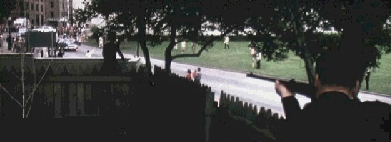The JFK 100
The Second Shot

The view from the grassy knoll

The view from the grassy knoll
Following the first shot, Stone's scenario continues:
Author and JFK consultant Gus Russo writes:CUT TO: the picket fence shooter hitting him from the fence. We see Kennedy (stand in) from the point of view of his telescopic sight. In the Zapruder film, we see Kennedy clutch his throat.(1)JIM (VOICE OVER) Frame 193 -- the second shot hits Kennedy in the throat from the front. Frame 225 -- the President emerging from the road sign. He obviously has been hit, raising his arms to his throat.
When one first stands behind the picket fence, he/she is struck by a number of sensations. First, there is no clear shot at the middle lane of Elm Street [where the limousine was] until the instant of the head shot, allowing for no earlier shots or tracking of the moving target. It turns out that the intended victim is obscured by road signs and a white retaining wall about ten feet in front of the fence.Such a shooter would have been standing only a few yards to the right of Abraham Zapruder and his receptionist, Marilyn Sitzman, who were perched on a pedestal several feet above the ground. When asked by Gus Russo about the possibility that someone was shooting from the knoll area, Sitzman replied, "That's absurd. I was only a few feet away, and I didn't hear or see anything suspicious."(3)An even more compelling problem was driven home during the filming of JFK. I was fortunate to be able to stand near the camera as this scene was reenacted. With the street crowd added as it appeared on the day of the shooting, it became clear that, insofar as the first two shots are concerned, a grassy knoll shot was also obstructed by the crowd that lined the sidewalk. The assassin would thus [have] had to shoot through the white wall, the road signs, and bystanders to get to the President.(2)
In fact, not a single person that day reported seeing anyone fire from the grassy knoll, despite the fact that the stockade fence is only five feet tall. Moreover, such a gunman would have been completely exposed on the sides and in the back, yet eyewitness Lee Bowers, in an elevated railroad tower some yards away, saw no one with a rifle, nor did he see anyone flee the area.(4)
Stone also errs in placing a shot in the area of Zapruder frame 193. His source is the House Select Committee (HSCA) Final Report of 1979, which theorizes a shot at this time on the sole basis of the acoustical evidence of a tape recording ostensibly made in Dealey Plaza at the time of the assassination.
Although no gun shots are audible on the tape, the Committee concluded that a noise spike on the recording represented a shot. It was later demonstrated by several independent studies that the impulse on the tape was not a gun shot, the microphone that made the recording was not in Dealey Plaza at the time, and that the recording, in fact, was made about a minute after the assassination.
With the demise of the so-called acoustical evidence, the possibility of a gun shot around Zapruder frame 193 also vanishes, as no other evidence supports the possibility. A great deal of evidence supports the hypothesis that the bullet to which the President is reacting in Zapruder frame 225 actually struck him in between frames 223 and 224 (see The JFK 100: The Single Bullet Theory).
NOTES:1. Oliver Stone and Zachary Sklar, JFK: The Book of the Film (New York: Applause, 1992), p. 164. All quotations are from the shooting script and may vary slightly from the finished motion picture.
2. Gus Russo, Live by the Sword (Baltimore: Bancroft, 1998), p. 474.
3. Gus Russo, Live by the Sword (Baltimore: Bancroft, 1998), p. 474.
4. Years later, of course, a few people did come forward to claim they had seen a grassy knoll gunman. One is Jean Hill, who explicitly stated on November 22, 1963, that she did not see anyone fire from the knoll. Another is Ed Hoffman, a deaf-mute who claims he tried to relate his tale of seeing a man fire from the grassy knoll to a police officer, who did not understand him. Hoffman has changed key elements of his story numerous times, however, and his claims regarding activity behind the picket fence are specifically contradicted by the sworn testimony of Lee Bowers, Jr.